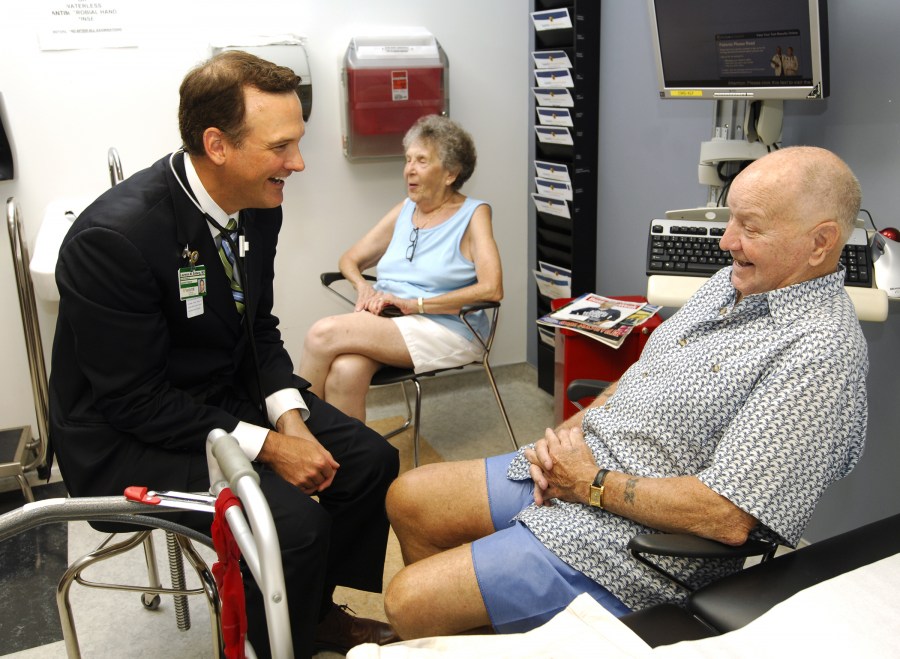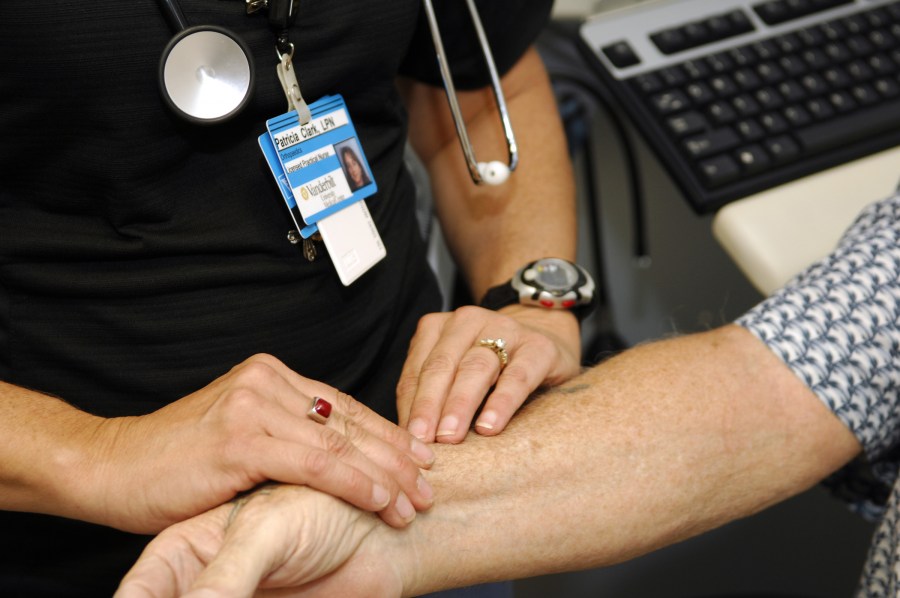
Laurence Solberg, M.D., left, talks with Geriatric Fracture Program patient Frank Sylvester and his companion, Helen O’Kane. (photo by Anne Rayner)
Elderly fracture program helps speed recoveries
Vanderbilt University Medical Center's Geriatric Fracture Program is designed to help seniors get back on their feet more quickly following one of life's literal breaks.
The program, which unites specialists from Emergency Medicine, Orthopaedic Surgery and Geriatric Medicine, has two major goals — to reduce the time to surgery for elderly patients who've suffered a fracture, and to minimize side effects during post-surgical care.
Laurence Solberg, M.D., assistant professor of Medicine and head of the Geriatric Consult Service, says fractures are a leading contributor to death and disability in the elderly population, and are projected to cost the country as much as $54.9 billion by 2020.
“As many as half of all seniors who suffer a fracture from a fall die within a year of treatment. Numerous studies show getting an elderly patient to the OR in 24 to 48 hours significantly improves their outcome. There is an association with delays in treatment and recovery and the complexity of their care,” said Solberg.
Frank Sylvester, 77, was in pretty good shape, or so he thought, when he collapsed at a gas station near his home in Goodlettsville, Tenn. When he woke up in the hospital, doctors told him he had broken his pelvis.
“They told us he would be in a wheelchair for about six months,” said his companion, Helen O'Kane.
Sylvester was transferred to Vanderbilt and received an efficient evaluation in the Emergency Department. A complex, seven-hour surgical repair took place within 24 hours of his transfer. Surgical stabilization of a broken bone can help reduce pain and speed recovery, which is important because even after just three days of bed rest, an older adult can lose 30 percent of their strength.
“The X-ray looks like they had to put a bicycle chain across my hip to hold it together,” said Sylvester, who was up and around after six weeks, using a walker or a cane.
“I am not used to being laid up. I need to slow down and learn to bide my time,” Sylvester says with a smile.
Older patients with fractures can be among the most complex patients seen in the hospital. Between the blood thinners, osteoporosis treatments and pain medications, Sylvester's surgeon, Erika Mitchell, M.D., assistant professor of Orthopaedics and Rehabilitation, said working with a Geriatrics consultant gave her peace of mind.
“Mr. Sylvester required a big operation. Not a small deal for a 77-year-old with heart disease and diabetes. I depend on my medical and geriatric colleagues to make surgery as safe as possible,” Mitchell said.

Patricia Clark, L.P.N., examines Frank Sylvester at Vanderbilt’s Geriatric Fracture Program. (photo by Anne Rayner)
Trauma, physical and occupational therapy, pharmacy and social work specialists all work together under the Geriatric Fracture Program. Solberg helps everyone stay on the same page.
“The prevention of delirium after surgery is an important goal for this population. I can keep everyone informed regarding the balance of medications, which is complex in this age group. It takes a little bit of the burden off the primary care doctors in the weeks after surgery,” Solberg said.
Solberg is keeping track of patients who have been through the Geriatric Fracture Program to see if outcomes improve, and if costs are reduced.
“We all know there is a large baby boom population coming in the next few years and these seniors are more active, playing golf or traveling. The goal of this program is to get them back to that active lifestyle while preventing complications and future injuries,” said Mitchell.













